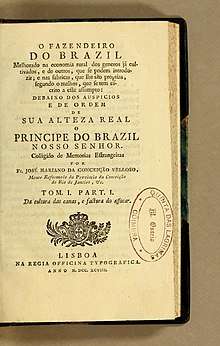José Mariano de Conceição Vellozo
José Mariano de Conceição Vellozo (also called José Mariano da Conceição Velloso) (1742–1811) was a Colonial Brazilian botanist who catalogued specimens, for example: Cedrela fissilis Vell. in Florae Fluminensis (1825–27; 1831). He was born in Tiradentes, formerly called São José do Rio das Mortes, state of Minas Gerais; and died in Rio de Janeiro, state of Rio de Janeiro. While at the University of Coimbra in Portugal in the 1790s he worked with Martim Francisco Ribeiro de Andrada in translating works on mineralogy and agriculture.[1] The standard author abbreviation Vell. is used to indicate this person as the author when citing a botanical name.[2]
| José Mariano de Conceição Vellozo | |
|---|---|
 | |
| Born | 1742 |
| Died | 14 July 1811 |
The publishing history of Florae Fluminensis is a most curious one. Encouraged by the Viceroy, Luiz de Vasconcelos, Vellozo spent 25 years studying and collecting the Brazilian flora. In 1790 he voyaged to Lisbon, intent on publication of his work, with descriptions of 1640 species and 1700 illustrations, created by Friar Francisco Solano and Antonio Alvares. In 1792 the Portuguese government approved publishing and sent the illustrations to Venice for engraving. When 554 plates had been completed the French invaded Portugal, and the Portuguese government relocated to Brazil, Vellozo returning to the monastery in Rio de Janeiro, where he died in 1811, having left his manuscripts to the Royal Library.
They were later discovered by Friar Antonio de Arrábida, and Emperor Pedro I ordered that the work be published. The plates were taken to the eminent lithographer Senefelder in Paris. Pedro I commissioned a print run of 3000 copies, a decision considered excessive by F.J. Knecht, the successor to Senefelder, and various Parisian scientists. The Brazilian government, though, was not to be deterred, and when printing was close to completion they cancelled the contract, because of political turmoil which led to the abdication of Emperor Pedro I. Despite these difficulties the printing run was finished by Knecht and shipped to Brazil, taking up an enormous amount of space in the Government offices. The Brazilian government never did settle their account and only a small number of copies were distributed. [3]
Works

- Dickson James; Vellozo (ed.) Plantarum Cryptogamicarum Britanniae Lusitanorum Botanicorum (1800)
- Florae Fluminensis (1825–27; 1831) Main work
- O Fazendeiro do Brasil (1798–1806)
References
- Carauta, J. P. P. The Text of Vellozo's Flora Fluminensis and Its Effective Date of Publication Taxon, Vol. 22, No. 2/3 (May, 1973), pp. 281–284.
- Varela, Alex Gonçalves; Lopes, Maria Margaret (July–September 2007). "As atividades científicas do naturalista Martim Francisco Ribeiro de Andrada na capitania de São Paulo (1800-1805)". História, Ciências, Saúde-Manguinhos. Rio de Janeiro. 14 (3). ISSN 0104-5970. Retrieved 2014-02-16.CS1 maint: ref=harv (link)
- IPNI. Vell.
- https://www.antiquariaatjunk.com/download/cat295.pdf
External links
- (in Portuguese) José Mariano da Conceição Veloso Biography
- Works by José Mariano da Conceição Veloso at Project Gutenberg
- Works by or about José Mariano de Conceição Vellozo at Internet Archive
- Complete digital facsimiles of volumes 1-5 of O fazendeiro do Brazil (Lisbon, 1798) in the John Carter Brown Library's collection on Internet Archive